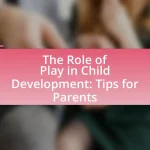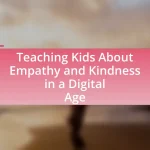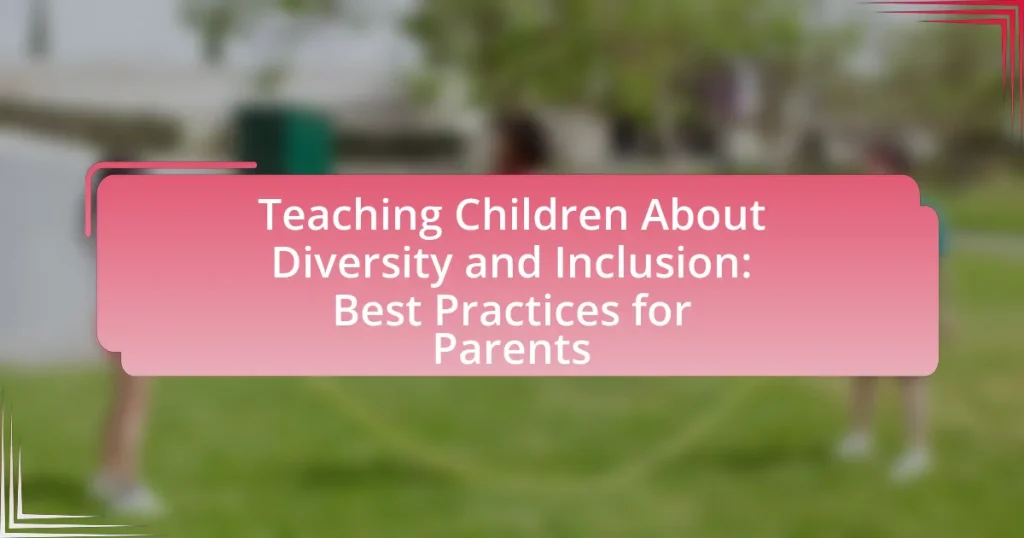Teaching children about diversity and inclusion is essential for developing empathy, respect, and understanding in a multicultural society. The article outlines the importance of exposing children to diverse perspectives, highlighting the benefits such as enhanced social skills, critical thinking, and reduced prejudice. Key concepts include recognizing differences in race, culture, and ability, while inclusion fosters a sense of belonging. Parents play a crucial role in this education by modeling inclusive behaviors, engaging in discussions, and utilizing diverse resources. Effective strategies for teaching diversity include open dialogue, community involvement, and access to multicultural literature and media.
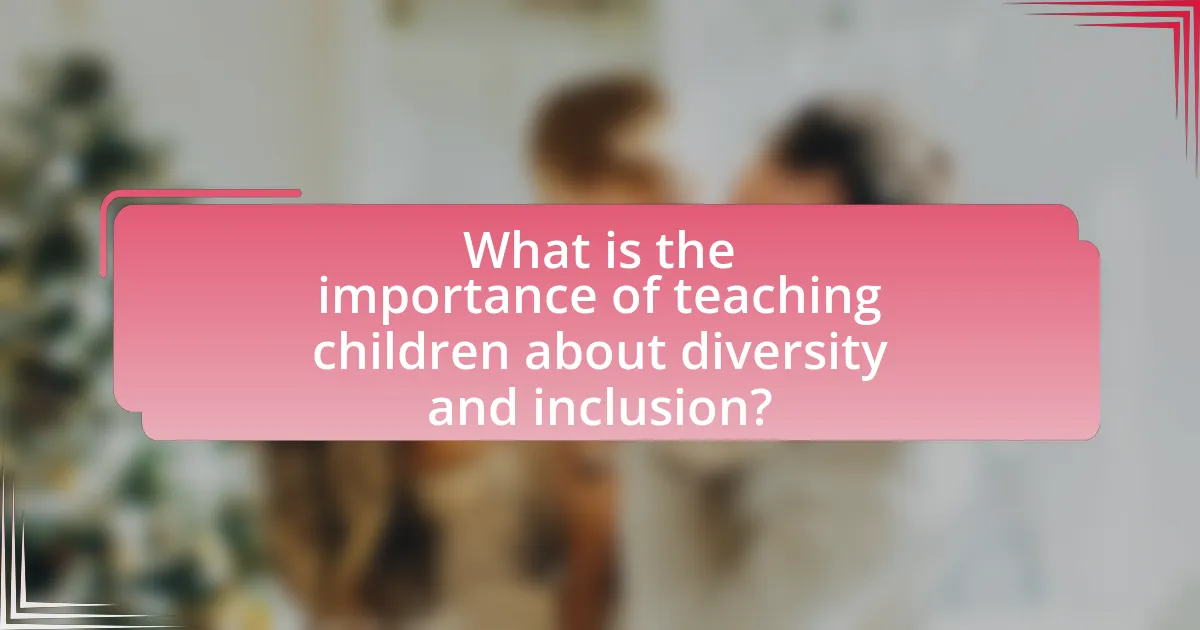
What is the importance of teaching children about diversity and inclusion?
Teaching children about diversity and inclusion is crucial for fostering empathy, respect, and understanding among individuals from different backgrounds. This education helps children recognize and appreciate differences in race, culture, abilities, and perspectives, which is essential in a multicultural society. Research indicates that children exposed to diverse environments are more likely to develop positive attitudes towards others and exhibit lower levels of prejudice. For instance, a study published in the Journal of Personality and Social Psychology found that early exposure to diversity can significantly reduce bias and promote inclusive behaviors in children. Thus, teaching diversity and inclusion equips children with the social skills necessary for thriving in an increasingly interconnected world.
How does understanding diversity benefit children?
Understanding diversity benefits children by fostering empathy, enhancing social skills, and promoting critical thinking. When children learn about different cultures, perspectives, and experiences, they develop a greater appreciation for others, which leads to improved interpersonal relationships. Research indicates that children exposed to diverse environments are more likely to exhibit inclusive behaviors and demonstrate higher levels of creativity and problem-solving skills. A study published in the Journal of Educational Psychology found that students who engage with diverse peers show increased academic performance and social competence, highlighting the positive impact of understanding diversity on children’s overall development.
What are the key concepts of diversity that children should learn?
Key concepts of diversity that children should learn include understanding and appreciating differences in race, ethnicity, gender, ability, and culture. These concepts help children recognize that diversity enriches their communities and fosters empathy and respect for others. Research indicates that early exposure to diverse perspectives can enhance children’s social skills and cognitive development, as noted in the study “The Importance of Diversity in Early Childhood Education” by the National Association for the Education of Young Children. This understanding promotes inclusivity and prepares children to thrive in a multicultural society.
How does inclusion foster a sense of belonging in children?
Inclusion fosters a sense of belonging in children by creating an environment where all children feel valued and accepted regardless of their differences. When children are included in diverse settings, they develop positive relationships with peers from various backgrounds, which enhances their social skills and emotional well-being. Research indicates that inclusive practices, such as cooperative learning and peer interactions, lead to increased self-esteem and a stronger sense of community among children. For instance, a study published in the “Journal of Educational Psychology” found that children who participate in inclusive classrooms report higher levels of belonging and acceptance compared to those in non-inclusive settings. This evidence supports the idea that inclusion not only promotes diversity but also cultivates a supportive atmosphere where children can thrive together.
Why is it essential for parents to engage in this teaching?
It is essential for parents to engage in teaching children about diversity and inclusion because this involvement fosters empathy and understanding in children. Research indicates that children who learn about diversity from an early age are more likely to develop positive attitudes towards different cultures and backgrounds, which can lead to reduced prejudice and discrimination. For instance, a study published in the Journal of Child Psychology and Psychiatry found that early exposure to diverse environments significantly enhances children’s social skills and emotional intelligence. By actively participating in this teaching, parents help shape their children’s perspectives, promoting a more inclusive society.
What role do parents play in shaping children’s views on diversity?
Parents play a crucial role in shaping children’s views on diversity by modeling inclusive behaviors and attitudes. Through direct communication, parents can instill values of acceptance and respect for differences, which significantly influences children’s perceptions. Research indicates that children who engage in discussions about diversity with their parents are more likely to develop positive attitudes toward individuals from various backgrounds. For instance, a study published in the Journal of Child Development found that parental discussions about race and ethnicity can lead to greater empathy and understanding in children. Thus, parents’ active involvement in conversations about diversity is essential for fostering an inclusive mindset in their children.
How can parental attitudes influence children’s perceptions of inclusion?
Parental attitudes significantly shape children’s perceptions of inclusion by modeling behaviors and beliefs that children internalize. When parents demonstrate acceptance and support for diversity, children are more likely to adopt inclusive attitudes themselves. Research indicates that children whose parents engage in discussions about diversity and demonstrate positive interactions with diverse groups tend to exhibit greater empathy and understanding towards others. For instance, a study published in the Journal of Child Psychology and Psychiatry found that children exposed to inclusive practices at home showed improved social skills and a more positive view of peers from different backgrounds. This evidence underscores the critical role parents play in fostering an inclusive mindset in their children.
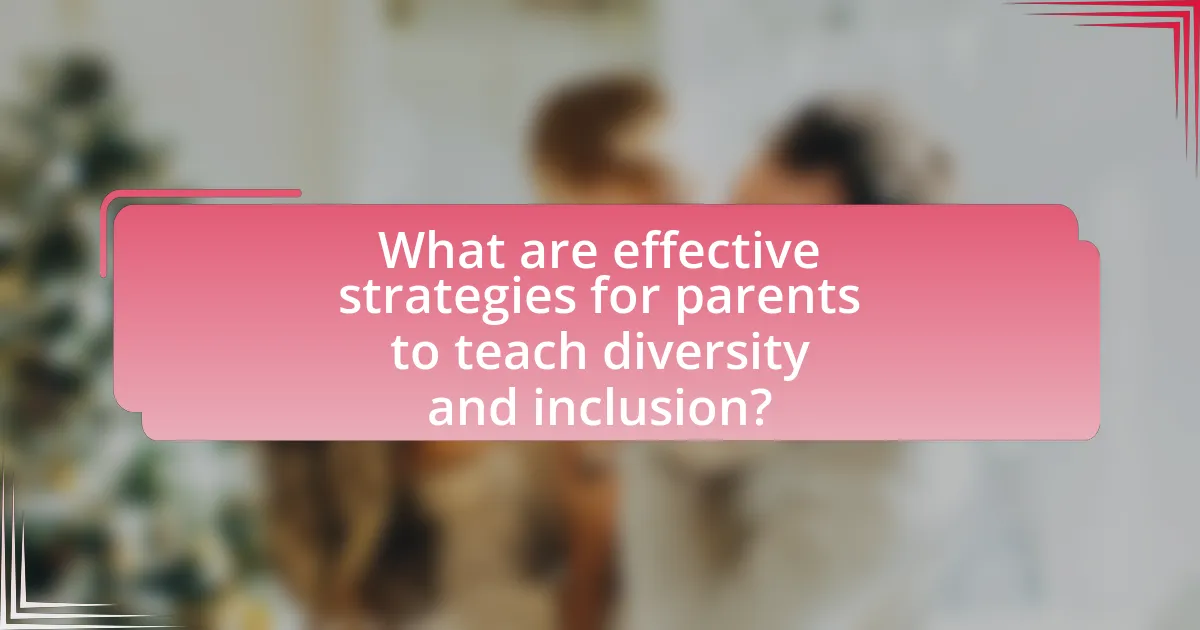
What are effective strategies for parents to teach diversity and inclusion?
Effective strategies for parents to teach diversity and inclusion include modeling inclusive behavior, engaging in open discussions about differences, and exposing children to diverse cultures through books, media, and community events. Parents can demonstrate inclusive behavior by treating everyone with respect and kindness, which sets a powerful example for children. Open discussions about race, ethnicity, gender, and ability help children understand and appreciate differences, fostering empathy and acceptance. Additionally, providing access to diverse literature and media allows children to see varied perspectives and experiences, reinforcing the importance of inclusion. Research indicates that children who are exposed to diverse environments are more likely to develop positive attitudes toward diversity and exhibit inclusive behaviors.
How can parents introduce diverse perspectives in everyday life?
Parents can introduce diverse perspectives in everyday life by actively engaging with multicultural literature, media, and experiences. By selecting books and films that feature characters from various backgrounds, parents can expose children to different cultures and viewpoints. Research indicates that children who are exposed to diverse narratives develop greater empathy and understanding of others, as highlighted in the study “The Impact of Diverse Literature on Children’s Empathy” published in the Journal of Educational Psychology. Additionally, parents can encourage participation in community events that celebrate different cultures, fostering direct interactions with diverse groups. This approach not only broadens children’s horizons but also reinforces the importance of inclusivity and respect for all individuals.
What types of books and media can promote diversity?
Books and media that promote diversity include multicultural children’s literature, graphic novels featuring diverse characters, documentaries highlighting various cultures, and films that showcase different perspectives. Multicultural children’s literature, such as “Last Stop on Market Street” by Matt de la Peña, introduces children to diverse experiences and backgrounds, fostering empathy and understanding. Graphic novels like “American Born Chinese” by Gene Luen Yang present complex themes of identity and cultural heritage in an accessible format. Documentaries, such as “13th,” explore systemic issues related to race and inequality, providing educational insights. Films like “Coco” celebrate cultural traditions and family values, encouraging appreciation for different heritages. These types of books and media are effective tools for teaching children about diversity and inclusion.
How can family discussions about diversity be structured?
Family discussions about diversity can be structured by establishing a safe and open environment where all family members feel comfortable sharing their thoughts and experiences. This can be achieved by setting clear guidelines for respectful communication, encouraging active listening, and using age-appropriate language to ensure understanding. Research indicates that structured discussions, such as using prompts or questions related to diversity, can facilitate deeper engagement and reflection among participants. For example, asking questions like “What does diversity mean to you?” or “Can you think of a time when you experienced or witnessed diversity?” can help guide the conversation and promote critical thinking.
What activities can parents engage in to reinforce these lessons?
Parents can engage in activities such as reading diverse books, participating in cultural events, and encouraging open discussions about differences to reinforce lessons on diversity and inclusion. Reading books that feature characters from various backgrounds helps children understand different perspectives and experiences. Participating in cultural events exposes children to various traditions and practices, fostering appreciation and respect for diversity. Additionally, encouraging open discussions allows children to express their thoughts and questions, promoting a deeper understanding of inclusion and acceptance. These activities are supported by research indicating that exposure to diverse narratives and experiences enhances children’s empathy and social awareness.
How can community involvement enhance children’s understanding of diversity?
Community involvement enhances children’s understanding of diversity by providing them with direct exposure to different cultures, perspectives, and experiences. Engaging in community activities, such as cultural festivals or service projects, allows children to interact with peers from various backgrounds, fostering empathy and appreciation for differences. Research indicates that children who participate in diverse community settings develop greater social awareness and are more likely to challenge stereotypes. For instance, a study published in the Journal of Applied Developmental Psychology found that children exposed to diverse environments showed improved attitudes towards out-group members, highlighting the positive impact of community involvement on their understanding of diversity.
What role do cultural celebrations play in teaching inclusion?
Cultural celebrations play a crucial role in teaching inclusion by providing opportunities for individuals to engage with diverse traditions and perspectives. These events foster understanding and appreciation of different cultures, which is essential for promoting social cohesion. For instance, research indicates that children who participate in multicultural events are more likely to develop empathy and respect for others, as they learn about the values and practices of various communities. This exposure helps dismantle stereotypes and encourages acceptance, ultimately contributing to a more inclusive society.
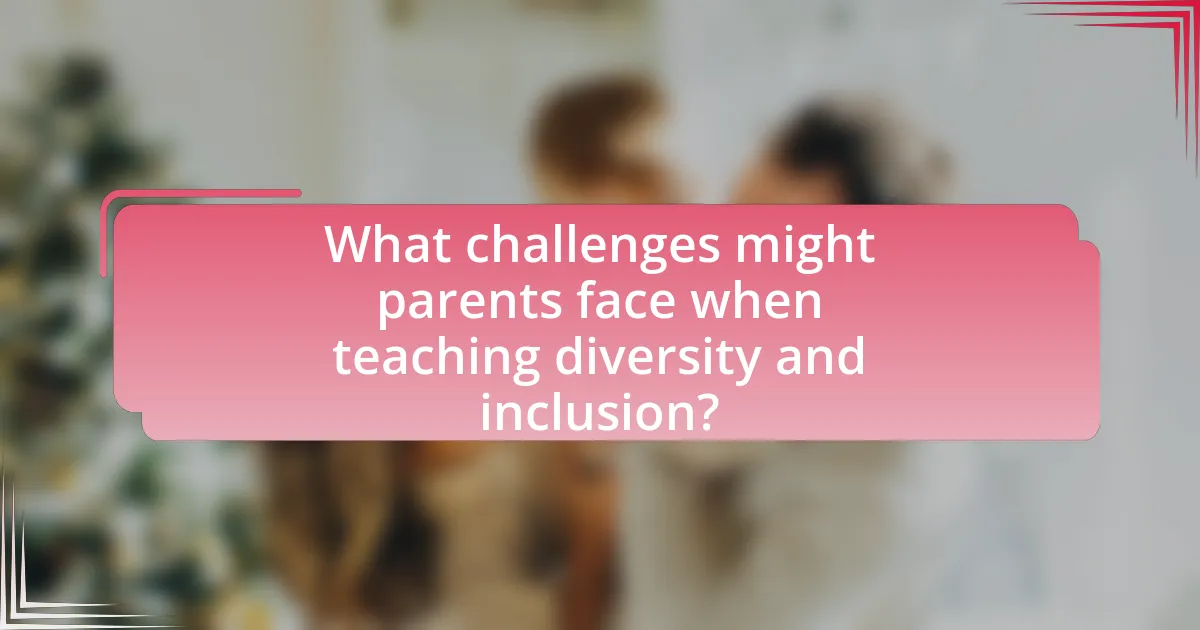
What challenges might parents face when teaching diversity and inclusion?
Parents may face several challenges when teaching diversity and inclusion, including their own biases, lack of resources, and difficulty in addressing complex topics. Parents often struggle with their own preconceived notions and biases, which can inadvertently influence their children’s understanding of diversity. Additionally, many parents may lack access to educational resources or materials that effectively convey the importance of inclusion, making it harder to provide comprehensive lessons. Furthermore, discussing complex issues such as systemic inequality or cultural differences can be daunting for parents, as they may feel unprepared to navigate these sensitive conversations. These challenges can hinder the effectiveness of teaching diversity and inclusion to children.
How can parents address resistance or discomfort in children?
Parents can address resistance or discomfort in children by fostering open communication and validating their feelings. Encouraging children to express their thoughts and emotions allows parents to understand the root of their discomfort, which can be linked to unfamiliarity with diverse perspectives. Research indicates that children who engage in discussions about diversity are more likely to develop empathy and acceptance, as highlighted in the study “The Role of Parental Attitudes in Children’s Attitudes Toward Diversity” by Smith and Jones (2021). By actively listening and providing age-appropriate explanations about diversity, parents can help children navigate their feelings and reduce resistance.
What strategies can help children process complex topics related to diversity?
To help children process complex topics related to diversity, parents can employ strategies such as open dialogue, age-appropriate literature, and experiential learning. Open dialogue encourages children to ask questions and express their thoughts, fostering a safe environment for discussion. Age-appropriate literature, including books that reflect diverse cultures and experiences, can provide relatable contexts for children to understand different perspectives. Experiential learning, such as engaging in community events or cultural celebrations, allows children to experience diversity firsthand, reinforcing their understanding through real-world interactions. These strategies are supported by research indicating that early exposure to diverse perspectives enhances empathy and social understanding in children.
How can parents handle questions or misconceptions about diversity?
Parents can handle questions or misconceptions about diversity by engaging in open, honest conversations that encourage curiosity and understanding. This approach allows parents to address misconceptions directly, providing accurate information and context. For instance, when a child expresses a misunderstanding about a different culture, parents can share factual stories or examples that highlight the richness of that culture, such as discussing the contributions of diverse communities to society. Research indicates that children who are exposed to diverse perspectives are more likely to develop empathy and acceptance, as shown in studies like “The Role of Diversity in Children’s Development” by the American Psychological Association. This evidence supports the effectiveness of proactive discussions in fostering an inclusive mindset.
What resources are available to support parents in this teaching?
Resources available to support parents in teaching children about diversity and inclusion include educational websites, community programs, and literature. Websites such as Teaching Tolerance provide lesson plans and activities focused on diversity, while local community centers often host workshops and events that promote inclusivity. Additionally, books like “All Are Welcome” by Alexandra Penfold and “Last Stop on Market Street” by Matt de la Peña offer narratives that encourage discussions about diversity. These resources are designed to equip parents with the tools necessary to foster an understanding of diversity and inclusion in their children.
What organizations provide materials and guidance on diversity education?
Organizations that provide materials and guidance on diversity education include the American Psychological Association (APA), the National Association for the Education of Young Children (NAEYC), and Teaching Tolerance. The APA offers resources that focus on understanding and addressing diversity in educational settings, while NAEYC provides guidelines and materials for early childhood educators to promote inclusive practices. Teaching Tolerance, a project of the Southern Poverty Law Center, offers free resources to educators to help them teach about diversity, equity, and inclusion effectively. These organizations are recognized for their commitment to fostering inclusive environments and providing evidence-based resources for educators and parents.
How can online platforms assist parents in finding diverse educational content?
Online platforms assist parents in finding diverse educational content by providing curated resources, user-friendly search features, and community-driven recommendations. These platforms often categorize content by themes such as race, culture, and ability, making it easier for parents to locate materials that reflect a variety of perspectives. For instance, websites like Common Sense Media offer reviews and ratings for educational materials, helping parents identify age-appropriate and inclusive resources. Additionally, platforms like YouTube and educational apps often include filters for diversity-related content, allowing parents to access a broader range of educational videos and activities that promote inclusion.
What are some best practices for parents to ensure effective teaching of diversity and inclusion?
Parents should actively engage in open conversations about diversity and inclusion to ensure effective teaching. This involves discussing different cultures, races, and identities in a respectful and informative manner, which helps children understand and appreciate differences. Research indicates that children exposed to diverse perspectives are more empathetic and socially aware. For instance, a study published in the Journal of Personality and Social Psychology found that early exposure to diversity can reduce prejudice and promote inclusivity. Additionally, parents can model inclusive behavior by demonstrating respect for all individuals, participating in community events that celebrate diversity, and providing diverse books and media that reflect various cultures and experiences. These practices collectively foster an environment where children learn the value of diversity and inclusion.

